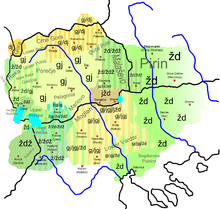
Macedonian is an Eastern South Slavic language. It is part of the Indo-European language family, and is one of the Slavic languages, which are part of a larger Balto-Slavic branch. Spoken as a first language by around 1.6 million people, it serves as the official language of North Macedonia. Most speakers can be found in the country and its diaspora, with a smaller number of speakers throughout the transnational region of Macedonia. Macedonian is also a recognized minority language in parts of Albania, Bosnia and Herzegovina, Romania, and Serbia and it is spoken by expatriate communities predominantly in Australia, Canada, and the United States.

Non-native pronunciations of English result from the common linguistic phenomenon in which non-native speakers of any language tend to transfer the intonation, phonological processes and pronunciation rules of their first language into their English speech. They may also create innovative pronunciations not found in the speaker's native language.

A digraph or digram is a pair of characters used in the orthography of a language to write either a single phoneme, or a sequence of phonemes that does not correspond to the normal values of the two characters combined.
The phonology of Standard German is the standard pronunciation or accent of the German language. It deals with current phonology and phonetics as well as with historical developments thereof as well as the geographical variants and the influence of German dialects.
The Catalan phonology has a certain degree of dialectal variation. Although there are two standard varieties, one based on Central Eastern dialect and another one based on South-Western or Valencian, this article deals with features of all or most dialects, as well as regional pronunciation differences.
The first Slovak orthography was proposed by Anton Bernolák (1762–1813) in his Dissertatio philologico-critica de litteris Slavorum, used in the six-volume Slovak-Czech-Latin-German-Hungarian Dictionary (1825–1927) and used primarily by Slovak Catholics.
English phonology is the system of speech sounds used in spoken English. Like many other languages, English has wide variation in pronunciation, both historically and from dialect to dialect. In general, however, the regional dialects of English share a largely similar phonological system. Among other things, most dialects have vowel reduction in unstressed syllables and a complex set of phonological features that distinguish fortis and lenis consonants.
Bernese German, like other High Alemannic varieties, has a two-way contrast in plosives and fricatives that is not based on voicing, but on length. The absence of voice in plosives and fricatives is typical for all High German varieties, but many of them have no two-way contrast due to general lenition.
A syllabic consonant or vocalic consonant is a consonant that forms the nucleus of a syllable on its own, like the m, n and l in some pronunciations of the English words rhythm, button and awful, respectively. To represent it, the understroke diacritic in the International Phonetic Alphabet is used, ⟨U+0329◌̩COMBINING VERTICAL LINE BELOW⟩. It may be instead represented by an overstroke, ⟨U+030D◌̍COMBINING VERTICAL LINE ABOVE⟩ if the symbol that it modifies has a descender, such as in.
In articulatory phonetics, fortition, also known as strengthening, is a consonantal change that increases the degree of stricture. It is the opposite of the more common lenition. For example, a fricative or an approximant may become a stop. Although not as typical of sound change as lenition, fortition may occur in prominent positions, such as at the beginning of a word or stressed syllable; as an effect of reducing markedness; or due to morphological leveling.
The phonology of Bengali, like that of its neighbouring Eastern Indo-Aryan languages, is characterised by a wide variety of diphthongs and inherent back vowels.
Unlike many languages, Icelandic has only very minor dialectal differences in sounds. The language has both monophthongs and diphthongs, and many consonants can be voiced or unvoiced.

The Prilep-Bitola dialect is a member of the central subgroup of the western group of dialects of Macedonian. This dialect is spoken in much of the Pelagonia region, as well as by the Slavic-speaking minority population in and around Florina (Lerin) in neighbouring Greek Macedonia. The Prilep-Bitola dialect, along with other peripheral west-central dialects, provides much of the basis for modern Standard Macedonian. Prestige dialects have developed in the cities of Bitola and Prilep.
The phonology of Welsh is characterised by a number of sounds that do not occur in English and are rare in European languages, such as the voiceless alveolar lateral fricative and several voiceless sonorants, some of which result from consonant mutation. Stress usually falls on the penultimate syllable in polysyllabic words, while the word-final unstressed syllable receives a higher pitch than the stressed syllable.
Nepali is the national language of Nepal. Besides being spoken as a mother tongue by more than 48% of the population of Nepal, it is also spoken in Bhutan and India. The language is recognized in the Nepali constitution as an official language of Nepal.

There is no standard variety of Scottish Gaelic; although statements below are about all or most dialects, the north-western dialects are discussed more than others as they represent the majority of speakers.
This article explains the phonology of Malay and Indonesian based on the pronunciation of Standard Malay, which is the official language of Brunei and Singapore, "Malaysian" of Malaysia, and Indonesian the official language of Indonesia and a working language in Timor Leste. There are two main standards for Malay pronunciation, the Johor-Riau standard, used in Brunei and Malaysia, and the Baku, used in Indonesia and Singapore.
Adyghe is a language of the Northwest Caucasian family which, like the other Northwest Caucasian languages, is very rich in consonants, featuring many labialized and ejective consonants. Adyghe is phonologically more complex than Kabardian, having the retroflex consonants and their labialized forms.
This article is about the phonology and phonetics of standard Slovene.
This article discusses the phonological system of the Greenlandic language.






